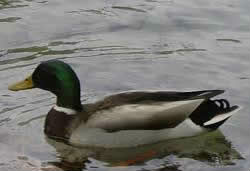Wild Ducks Info
The wild duck belongs to the Anatidae family of birds. Some of the best known members of this species are the Mallard, the Eider, and the Teal. The Mallard is probably the most common amongst all ducks, with a white neck ring, chestnut breast, and glossy-green head that distinguishes it. The Eider is a sea duck, mainly found around off-shore islands. Its soft down is used for stuffing pillows, quilts, cushions and lining for all manner of clothes. The Teal can be located in and around marshland and often gives the impression that it is standing on its head as it searches the bottom of the water for plants and seeds.
There are more than 150 different kinds of wild duck, which can be found in every region of the planet, with the exception of Antarctica. They can grow up to around 24 inches in length and can vary in their colour, either bright green, purple and bronze, mixing with grey, white and brown. The male of the species is referred to as a drake, with the female commonly known as a hen, and their young collectively called ducklings. The bird's soft textured feathers are extremely thick, and are made water-resistant by a film of oil which is released from a small gland above the tail, meaning that they do not get wet, or cold.
There are more than 150 different kinds of wild duck, which can be found in every region of the planet, with the exception of Antarctica. They can grow up to around 24 inches in length and can vary in their colour, either bright green, purple and bronze, mixing with grey, white and brown. The male of the species is referred to as a drake, with the female commonly known as a hen, and their young collectively called ducklings. The bird's soft textured feathers are extremely thick, and are made water-resistant by a film of oil which is released from a small gland above the tail, meaning that they do not get wet, or cold.
A duck's habitat consists of woodland areas, as ducks are migratory in nature. Ducks like wet and woody areas especially in warm and temperate climates. Domestic ducks are usually kept outdoors or in some cases in cages or duck houses.
Ducks exploit a variety of food sources such as grasses, aquatic plants, fish, insects, small amphibians, worms, and small molluscs. They are opportunistic and therefore they will eat fruit, seeds and aquatic plants, as well.
The ducks are generally monogamous, although these bonds generally last a single year only. Larger species and the more sedentary species tend to have pair-bonds that last numerous years. Most duck species breed once a year, choosing to do so in favorable conditions (spring/summer or wet seasons). Ducks also tend to make a nest before breeding. Although mother ducks are very caring and protective of their young, they are not above abandoning some of their ducklings if they are physically stuck in an area they cannot get out of or are not prospering due to genetic defects or sickness brought about by hypothermia, starvation, or disease. Ducklings can also be orphaned by inconsistent, late hatching where a few eggs hatch long after the mother has abandoned the nest.
Whenever you go hunting for ducks, you should take into account the dogs as well. As duck hunting involves water, retrievers are very valuable and can be very helpful hunters. However, there are a variety of things you should take into account when going duck hunting. If you want to improve your hunting techniques, check out our tips & tricks section.
Did you know that the baby ducks are called ducklings and the males are called drakes? Also, although ducks are monogamous, they do not mate for life. However, they take care of their ducklings very thoroughly. Hens do their best to give her eggs the best possible cushioning and insulation.
Ducks exploit a variety of food sources such as grasses, aquatic plants, fish, insects, small amphibians, worms, and small molluscs. They are opportunistic and therefore they will eat fruit, seeds and aquatic plants, as well.
The ducks are generally monogamous, although these bonds generally last a single year only. Larger species and the more sedentary species tend to have pair-bonds that last numerous years. Most duck species breed once a year, choosing to do so in favorable conditions (spring/summer or wet seasons). Ducks also tend to make a nest before breeding. Although mother ducks are very caring and protective of their young, they are not above abandoning some of their ducklings if they are physically stuck in an area they cannot get out of or are not prospering due to genetic defects or sickness brought about by hypothermia, starvation, or disease. Ducklings can also be orphaned by inconsistent, late hatching where a few eggs hatch long after the mother has abandoned the nest.
Whenever you go hunting for ducks, you should take into account the dogs as well. As duck hunting involves water, retrievers are very valuable and can be very helpful hunters. However, there are a variety of things you should take into account when going duck hunting. If you want to improve your hunting techniques, check out our tips & tricks section.
Did you know that the baby ducks are called ducklings and the males are called drakes? Also, although ducks are monogamous, they do not mate for life. However, they take care of their ducklings very thoroughly. Hens do their best to give her eggs the best possible cushioning and insulation.
General Info
Equipment & Tools








